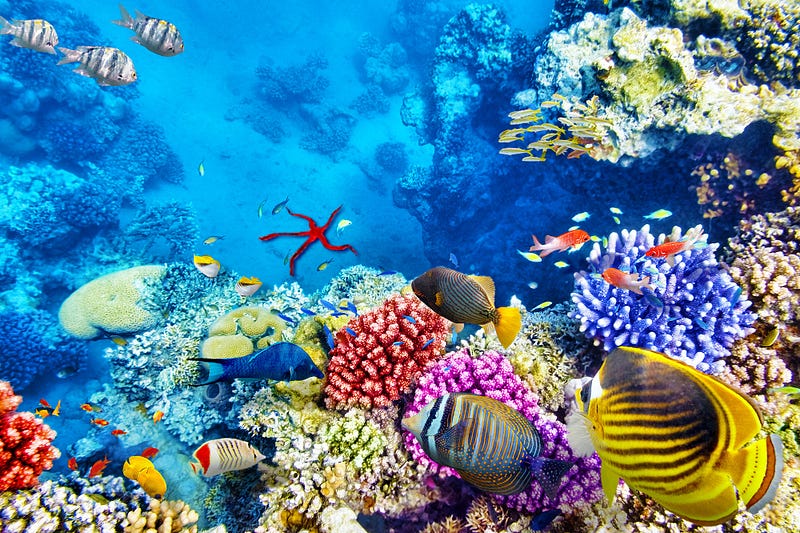Discovering the Marvels of Coral Reefs and Their Biodiversity
Written on
Chapter 1: The Enchantment of Coral Reefs
Beneath the waves of our planet’s oceans exists a captivating world rich with life and color: the coral reef. These stunning underwater landscapes are not only breathtaking but also vital ecosystems that harbor an astonishing variety of marine organisms. In this article, we will journey through the wonders and importance of coral reefs, revealing the secrets of the ocean depths that fascinate scientists, conservationists, and ocean lovers alike.
Section 1.1: Biodiversity Hotspots
Often dubbed the "rainforests of the sea," coral reefs boast an unmatched level of biodiversity. Although they occupy a mere fraction of the ocean floor, they are home to nearly 25% of all marine species. The complex structures of coral offer habitat, breeding areas, and a steady food supply for numerous marine creatures.
Subsection 1.1.1: Vibrant Coral Ecosystems

Coral reefs are famous for their brilliant colors, which arise from the symbiotic relationship between coral polyps and algae. These algae, known as zooxanthellae, inhabit the coral tissues and provide energy through photosynthesis. This partnership not only enhances the vivid colors of coral reefs but also supports the overall health of the ecosystem.
Section 1.2: A Spectrum of Marine Life
From the charming clownfish weaving through sea anemones to the elegant gliding of sea turtles and the imposing presence of larger species like sharks and rays, coral reefs are home to an extraordinary variety of marine life. The vibrant interplay of colors and forms in this ecosystem exemplifies the fragile balance that sustains underwater life.
Chapter 2: Challenges Facing Coral Reefs
In the video "Breathtaking Underwater Scenes | Marine Life & Coral Reef 4K," viewers can immerse themselves in the stunning visuals of marine life and coral ecosystems, highlighting their beauty and complexity.
The Threats to Coral Reefs
Climate Change and Coral Bleaching: One of the gravest threats to coral reefs is climate change. Rising ocean temperatures result in coral bleaching—a process where the essential partnership between coral and algae deteriorates, leading to the loss of vibrant colors and increased vulnerability to disease.
Overfishing and Destructive Practices: Overfishing and harmful fishing techniques, such as blast and cyanide fishing, further threaten coral reef ecosystems. These practices not only impact targeted species but also inflict damage on the fragile coral structures themselves.
Pollution and Runoff: Pollution from land, including agricultural runoff and improper waste management, introduces harmful sediments, nutrients, and toxins into coastal waters. This pollution can severely degrade water quality, negatively affecting coral reefs and the marine life that relies on them.
Chapter 3: Conservation Initiatives and Future Prospects
In the video "4K Underwater Wonders - Relaxing Music - Coral Reefs, Fish and Colorful Sea Life," viewers can relax while exploring the serene beauty of underwater environments, promoting awareness of their conservation.
Marine Protected Areas: The establishment of marine protected areas (MPAs) is essential for the conservation of coral reefs. These designated regions restrict certain human activities, allowing marine ecosystems to recover and flourish. Effectively managed MPAs can act as reservoirs of biodiversity and resilience.
Community Engagement and Education: Involving local communities in conservation efforts is crucial for the sustainable management of coral reefs. Educational programs, community-based monitoring, and responsible tourism can foster a sense of stewardship and encourage respectful interactions with marine environments.
Scientific Advancements and Research: Continued scientific exploration and technological innovation, including coral reef monitoring systems and underwater drones, enhance our understanding of these ecosystems. This knowledge aids in the development of conservation strategies and identifies resilient species that can endure environmental changes.
Conclusion
Delving into the underwater wonders of coral reefs reveals an unparalleled world of beauty and ecological importance. As guardians of our planet, we share a collective duty to protect and preserve these delicate ecosystems. Through dedicated conservation efforts, sustainable practices, and a commitment to environmental education, we can ensure that future generations will continue to be amazed by the stunning diversity and resilience of coral reefs and the marine life they support.